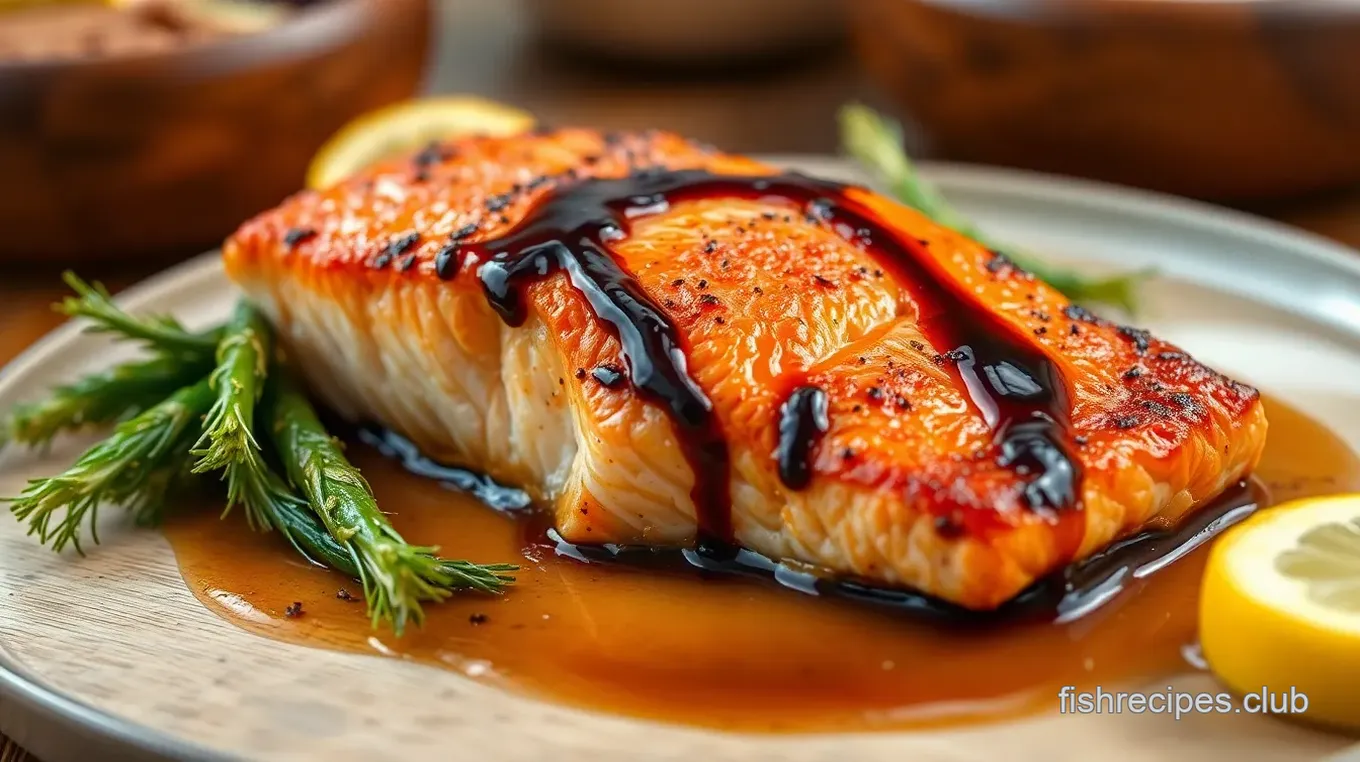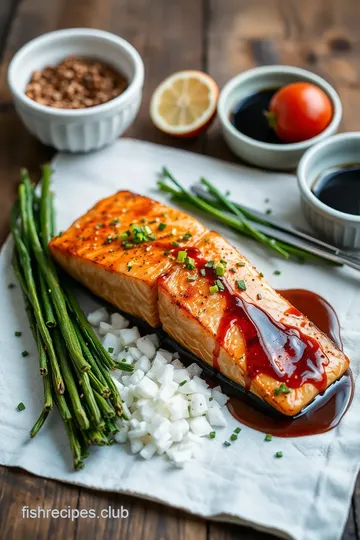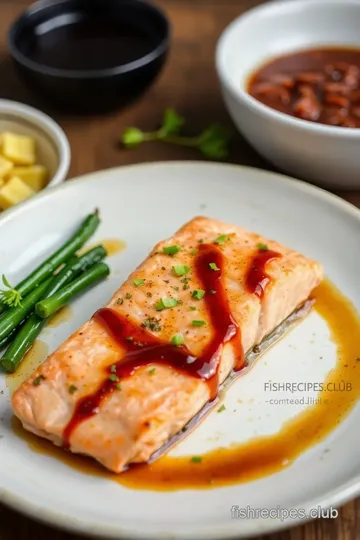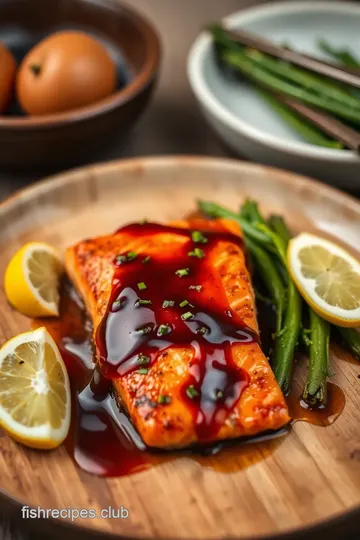Baked Salmon with Miso Glaze
Wondering how to impress with an easy dinner? My Broiled Salmon with Miso Glaze | 18 Minutes is your answer! It’s delicious, quick, and packed with umami goodness.

look into into Broiled Salmon with Miso Glaze | 18 Minutes
Oh my gosh, do i have a story for you! picture this: a long week at work, and all i want is a delicious, stress-free dinner that takes less time than my nightly scrolling on tiktok.
One evening, i stumbled upon the broiled salmon with miso glaze | 18 minutes recipe, and let me tell you, it changed my life! the idea alone—flaky salmon with a rich, savory-sweet glaze—had me salivating.
Could something so tasty really be ready in just 18 minutes? spoiler alert: it totally can, and it’s a total game-changer for easy salmon recipes!
A Little Taste of History
Miso is like the cool, hip cousin of cooking ingredients. it hails from japan and has been a staple for centuries.
This fermented soybean paste is packed with umami flavor. it's not just a trend; it’s a tradition. nowadays, this miso salmon recipe has skyrocketed in popularity, making its way into homes like mine across america, where quick, healthy meals are the name of the game.
As for time? we’re looking at about 10 minutes of prep time and just 8 minutes under the broiler.
You’ll definitely want to check your watch because it’s that fast. not to mention, it’s super cost-effective—each serving will absolutely fit into your weeknight dinner recipes without breaking the bank.
Why You’ll Love This Recipe
Alright, let’s get down to the good stuff. first off, health benefits ? you better believe it. salmon is loaded with omega-3 fatty acids, which are excellent for your heart.
It's also a high-protein meal, making it the perfect option if you're trying to keep things nutritious.
And can we talk about flavor? that miso glaze is the star of the show! it strikes the right balance between sweet and savory, giving your taste buds a party.
Not to mention, it’s totally family-friendly. your picky eaters might just ask for seconds, especially when paired with something like sautéed veggies or a side of rice.
The Perfect Occasion
Want to impress your dinner guests without a ton of fuss? this dish is your secret weapon. it’s fancy enough for a special occasion but easy enough for a tuesday night.
Think of it as one of those quick fish dishes that can really steal the spotlight, even on a busy weeknight.
The unique selling points here include its nutritional value and that dreamy umami flavor that makes you feel like you’re dining at a high-end restaurant without having to dress up!
Getting Started
Before i dive into the ingredients, i should mention a couple of quick tips. always choose fresh salmon for the best taste.
Seriously; invest in quality. and when it comes to broiling, keep an eye on it! we don’t want to go from perfectly caramelized to charred in a matter of seconds.
Now, if you're ready to embrace this culinary adventure, let’s take a peek at what you’ll need to whip up this amazing dish!

Essential Ingredients Guide
Cooking is like painting—your ingredients are the colors that bring your masterpiece to life. if you want to whip up some easy salmon recipes , like the broiled salmon with miso glaze | 18 minutes , let’s break down the essentials.
Premium Core Components
First things first, let's talk about the measures . whether you're pouring in 3 tablespoons of white miso paste or balancing your 2 tablespoons of honey , having the right amounts is crucial.
We’re talking about 45g of miso and 42g of honey for those keeping eye on grams.
When you’re shopping, pick your ingredients like you're swiping right on a dating app. look for those quality indicators ! fresh salmon should have a bright, vibrant color and smell like the ocean—not fishy or funky.
As for the miso , it better be smooth and error-free in texture.
Now, once you're home, how you store these babies matters. keep that miso in the fridge after opening, and it should last a couple of months.
But salmon? it's a whole other story! it’ll only last 1-2 days in the fridge, so use it or lose it!
Signature Seasoning Blend
Now let’s spice things up! when it comes to essential spice combinations , think about a balance of sweet and savory.
The sweet honey in our glaze pairs perfectly with the umami of miso. you can also play around with herbs; for instance, ginger and garlic are a-listers for asian-inspired meals.
Want to get fancy? Try adding sesame oil or sriracha for a kick! And don’t forget alternative seasoning options . If you’re feeling adventurous, go for a Teriyaki glaze instead!
Smart Substitutions
Sometimes life throws you a curveball—like you realize you’re out of honey, which is key for our miso salmon recipe.
No biggie! you can swap honey for maple syrup or even agave . if you're looking for gluten-free options, just use tamari instead of soy sauce.
Oh, and here’s a pro tip for when you don’t have salmon but need a quick fish dish—try trout or halibut . They cook similarly and hold flavors just as well!
Kitchen Equipment Essentials
Honestly, cooking can make you feel like a mad scientist. you don’t need a ton of fancy gadgets, just the right tools will do.
You definitely need an oven broiler —this is your best friend for achieving that glorious caramelized glaze. if you don’t have parchment paper, that’s okay too; you can just clean your sheet afterward!
Preparation is key! Make sure you’ve got a mixing bowl and a whisk handy to whip up that delicious miso glaze. Don’t forget your baking sheet for broiling!
Wrapping Up
So, whether you’re devising nutritious dinner ideas that are quick or looking for healthy weeknight dinner recipes , this guide has got your back.
Keeping things simple yet flavorful is the name of the game. and trust me, once you master those broiling techniques , you’ll be able to whip up quick and healthy recipes in no time.
Now that you've got your essentials down, ready to create a sensational dish? Stay tuned, because the next section will guide you through the instructions for the Broiled Salmon with Miso Glaze | 18 Minutes , all while making sure it’s as fun and fulfilling to make as it is to eat! Let's get cooking, friends!
Professional Cooking Method: Elevate Your Dinner Game
Cooking might sometimes feel like a whirlwind, but with the right approach, you can turn that chaos into a delicious masterpiece.
I’m talking about some professional cooking methods that elevate your meals—from easy salmon recipes to sumptuous japanese-inspired meals . let's break it down step by step.
Essential Preparation Steps
Alright, let’s kick things off with mise en place —fancy french for “everything in its place.” honestly, this is a game-changer.
Before you even turn on that oven, chop your garlic, mince your ginger, and measure out that miso glaze (seriously, try this miso salmon recipe ).
Having everything ready helps you sail through the recipe without scrambling.
Next up, time management tips . set a timer. for the broiled salmon with miso glaze | 18 minutes , you can split your time into prep and cook phases.
You’ve got 10 minutes of active prep then just 8 minutes broiling. make every minute count!
Don’t forget about organization! keep your workspace tidy. line up your ingredients—this makes things less stressful. and safety? keep that fire extinguisher nearby.
Seriously, if you’re broiling, safety is key. never leave your oven unattended.
Step-by-Step Process
Now let’s get down to business with clear, numbered instructions. Follow these steps for success:
-
Prepare the Miso Glaze: Mix 3 tablespoons of white miso paste , 2 tablespoons honey , and the other glaze ingredients until it's smooth.
-
Prepare the Salmon: Preheat that oven broiler to high—this is crucial! Your salmon needs to be about 6 inches from the heat for perfect results.
-
Apply the Glaze: Brush or spoon the miso mixture generously across your 2 salmon fillets . Trust me; this glaze is like a hug for your fish.
-
Broil: place the baking sheet under the broiler and watch closely. broil for 6- 8 minutes or until the fish reaches an internal temp of 145° f .
You’re looking for that lovely caramelization—it's where the magic happens!
-
Serve: After letting it rest for a minute, drizzle any remaining glaze over the top. Plate that beauty and admire your work.
Expert Techniques
Broiling may sound simple, but there are professional methods that you can master. for one, keep an eye on that timing precision ! it’s all about hitting that sweet spot of doneness.
Under-cooked salmon? no thanks. overcooked? yikes! don’t be afraid to use visual cues—look for that flaky love we all crave.
Success Strategies
We’ve all been there—those kitchen disasters that make you want to hide. avoid typical blunders like forgetting to season your salmon properly.
A little salt and pepper before you glaze go a long way.
Also, be mindful of your quality checkpoints . Check that glaze consistency before you slap it on. You want it to stick but not drown your salmon!
And whatever you do, don’t skip the resting time after broiling. This step turns every bite into a juicy culinary treasure.
Final Thoughts
Don’t shy away from making this dish ahead of time. the glaze keeps well, and you'll be just a quick broil away from a fabulous meal.
The broiled salmon with miso glaze | 18 minutes is all about efficiency and flavor—a real winner for those busy weeknight dinners .
So there you go! you’ve got pro tips, expert techniques, and a simple path to a flavorful dinner that can be on your table in no time.
Ready to nail this easy salmon recipe ? don't forget—fresh salmon brings those patented fresh salmon benefits that make your dish a winner.
Now that you’re all prepped to tackle tonight’s dinner with flair, let’s dive into some Additional Information that can help make your cooking journey even more delightful.

Mastering the Art of Broiled Salmon with Miso Glaze | 18 Minutes
Let me tell you, broiled salmon with miso glaze | 18 minutes is a total game changer for weeknight dinners! it's quick, packed with flavor, and the umami from the miso is just out of this world.
Whether you’re cooking for yourself or having a little dinner party with friends, this dish will elevate your culinary skills without breaking a sweat!
Pro Tips & Secrets
First off, let’s dive into some pro tips to level up your salmon game. using fresh salmon is key. seriously, don’t skimp here—go wild-caught if you can.
Fresh salmon not only tastes better, but it also gives the most delightful texture when cooked.
And about that glaze? feel free to play with the miso glaze ingredients . want it sweeter? add a bit more honey.
Want it saltier? just splash in more soy sauce. this recipe is literally about creating your flavor masterpiece!
For time-saving techniques , make the glaze ahead of time. mix it up in the morning, and you’ll only need 8 minutes to cook the salmon after your long day.
Easy peasy!
Perfect Presentation
Alright, let’s talk presentation. it’s all about the plating techniques ! once the salmon is perfectly broiled, place it on a cute plate, then drizzle that reserved glaze on top.
Toss in a sprinkle of sesame seeds or thinly sliced scallions for that added flair!
A little hint? pair it with something colorful, like bright green sautéed veggies or vibrant cherry tomatoes. color combinations can make all the difference when you're plating.
Trust me; your guests will be snapping pics before they even take a bite!
Storage & Make-Ahead
Now to the practical bit! if you've got leftovers (i know, hard to believe), you can store the salmon in an airtight container in the fridge for up to three days .
Reheating can be tricky, though; just pop it in the oven for a few minutes to keep it tender—nobody wants dried-out salmon, right?
Making this recipe ahead of time? no worries! just prep your glaze a day in advance and keep it in the fridge.
It’ll be waiting for you when you're ready to whip up this easy salmon recipe .
Creative Variations
Let’s get creative! there are so many fun miso salmon variations to try. feeling spicy? add some chili paste to your glaze.
Want a citrus kick? squeeze fresh lime juice over the top before serving.
If you’re looking for dietary modifications , switch the honey for agave syrup for a vegan option. you could also use tamari for a gluten-free glaze.
The possibilities are endless, so have fun making this dish your own!
Complete Nutrition Guide
Now you might be wondering, “what’s in this flavorful piece of fish?” well, here’s a quick breakdown. each serving has about 300 calories and 29g of protein .
That's what you call a high-protein meal ! plus, you’re getting those healthy fats from the salmon. it’s a total win-win in the nutrition department!
If you're counting carbs, this is also a great low-carb dinner option ! just serve with some steamed veggies and you're golden.
And hey, who doesn’t feel good about a healthy dinner recipe that’s also super easy?
Expert FAQ Solutions
As i wrap up, let’s tackle some common questions. a lot of folks ask about the salmon seasoning options . honestly, stick to salt and pepper for this dish; the glaze is your star.
If your salmon still doesn’t seem flavorful, check your ingredients—freshness really matters in cooking with miso!
Thinking about serving wine? A light white goes beautifully, especially a Sauvignon Blanc or even a bit of sake for that total Japanese vibe.
Wrapping It Up
So, if you're ready to impress or just want an awesome dish for yourself, give this miso salmon recipe a shout.
Trust me, you'll be hooked – and in just 18 minutes ! cooking doesn’t have to be complicated; what really matters is the joy of sharing food with those you love.
Now get in the kitchen, roll up your sleeves, and let that miso magic happen! your taste buds will thank you!

Baked Salmon with Miso Glaze Card

⚖️ Ingredients:
- 3 tablespoons white miso paste
- 2 tablespoons honey
- 1 tablespoon soy sauce
- 1 tablespoon rice vinegar
- 1 teaspoon garlic, minced
- 1 teaspoon ginger, grated
- 2 (6-ounce) salmon fillets, skin on
- Salt, to taste
- Pepper, to taste
🥄 Instructions:
- Step 1: In a small bowl, combine white miso paste, honey, soy sauce, rice vinegar, garlic, and ginger. Whisk until smooth.
- Step 2: Preheat the oven broiler to high. Line a baking sheet with parchment paper (optional) for easy cleanup. Place the salmon fillets on the baking sheet, skin side down. Season moderately with salt and pepper.
- Step 3: Brush or spoon the miso glaze generously over each salmon fillet. Reserve some glaze for serving, if desired.
- Step 4: Transfer the baking sheet to the oven, positioning it about 6 inches from the broiler. Broil for 6-8 minutes, or until the salmon is cooked through and the glaze is caramelized (internal temperature should reach 145°F/63°C).
- Step 5: Remove from the oven and let sit for 1-2 minutes. Drizzle with reserved glaze, if using. Serve immediately.
Previous Recipe: How to Bake Tilapia with Garlic Butter in 22 Minutes: A Delicious Weeknight Dinner!
Next Recipe: How to Make Quick Shrimp Rice Noodle Soup: My Delicious Weeknight Go-To
